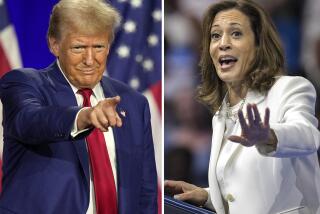Column: Is Biden’s ‘public option’ for healthcare already dead?

- Share via
Continuation of a divided Congress, with Republicans controlling the Senate and Democrats the House, would severely limit President-elect Joe Biden’s legislative agenda.
It also would probably mean the demise of his most ambitious healthcare proposal: A “public option” insurance plan that would compete with private plans and possibly serve as a transitional step to “Medicare for all.”
Although the U.S. Supreme Court indicated this week that it probably wouldn’t overturn the Affordable Care Act, the upshot for ordinary Americans is that meaningful healthcare reform may be doomed to remain an aspiration rather than a long-overdue reality.
“It doesn’t matter what party you’re with, everyone agrees our healthcare system isn’t working,” said Martin Gaynor, a professor of economics and health policy at Carnegie Mellon University.
“The public option is something that could offer some impressive upsides,” he told me. “I think it’s worth giving it a shot.”
Biden said after the Supreme Court heard oral arguments about the Affordable Care Act on Tuesday that his administration will do “everything in our power to ease the burden of healthcare on you and your families.”
His public option is not the single-payer insurance program long sought by progressives — a program that would place the U.S. healthcare system in step with those of most other developed nations.
Biden has pointedly said that’s not among his policy goals, although he’s in favor of lowering the Medicare eligibility age to 60 from 65.
His public option is being pitched to both progressives and conservatives as a compromise.
It would serve as an affordable insurance alternative to people who are unable to secure private coverage or who are dissatisfied with their current coverage choices.
“If your insurance company isn’t doing right by you, you should have another, better choice,” Biden’s campaign website says.
“The public option, like Medicare, will negotiate prices with providers, providing a more affordable option for many Americans who today find their health insurance too expensive,” it says.
Details are lacking.
How much would it cost? How much would it reimburse medical providers? Would all doctors and hospitals be required to accept it, or could they reject public-option patients just as some now refuse to see Medicaid patients?
Presumably, the aim of a public option would not just be to provide greater access to coverage but also to pressure private insurers to offer more competitive rates.
If a public-option plan is required to merely break even, rather than turn a profit, it theoretically could undercut the pricing of private plans and force them to introduce lower premiums, deductibles and co-pays.
If it attracts sicker people with preexisting conditions, that would reduce the risk level of private plans, which in theory would incentivize them to cut prices.
By the same token, if a cheaper public option attracted younger, healthier people, that too could push private plans to be more competitive in hopes of winning back the most profitable of customers.
“There are a number of different scenarios,” Gaynor said. “The details are really going to matter.”
The general sense among many healthcare experts is that a public option would be a no-go with Republicans because it would make things tougher for private insurers (not to mention it would represent a reversal from past opposition to the proposal).
“They think it will lead to lower fees and more transparency,” said Frank Sloan, a professor emeritus of health policy and management at Duke University.
What’s wrong with that?
“Nothing!” Sloan replied. “Those would be good things. There’s no reason not to give a public option a try.”
The Affordable Care Act originally included a public option. It was dropped to make the bill more palatable for Republicans who resisted the legislation every step of the way, and who started undermining it as soon as it was passed.
Most observers see little appetite among Republican senators for revisiting the idea, so it’s unlikely — unless Georgia miraculously sends a couple of Dems to the Senate after a January runoff — that any such bill would receive full congressional backing.
And that means, yet again, American healthcare consumers would be shortchanged.
The problems with the U.S. healthcare system are well known. Americans spend about $4 trillion annually on healthcare. On a per-person basis, we spend roughly double what most other developed countries spend.
Meanwhile, we come up short on two key yardsticks of healthcare efficacy — life expectancy and infant mortality. People overseas who pay less than we do for care typically enjoy longer lives and lower rates of infant deaths.
The Affordable Care Act — a.k.a. Obamacare — extended coverage to about 20 million people who had lacked health insurance, bringing the number of uninsured to a historic low.
After President Trump took office in 2017, the number of uninsured started climbing again as he set about dismantling the healthcare law.
According to the Kaiser Family Foundation, the percentage of nonelderly Americans without health insurance rose from 10% in 2016 to 10.9% last year. More than 2 million people lost coverage during that period.
Because of the COVID-19 pandemic and related job losses, the foundation said, “the number of uninsured has likely increased further in 2020.”
Trump repeatedly pledged since before taking office that he would replace the Affordable Care with a cheaper, more comprehensive plan — a “beautiful” plan, as he put it.
He said his approach would include all the goodies that people like, such as protections for people with preexisting conditions, and none of the stuff they don’t, such as an individual mandate that makes protections for preexisting conditions financially feasible.
That hasn’t happened. And now it never will as Trump prepares to exit the White House with a “promises made” list that’s longer than his “promises kept” list.
Ironically, Trump won’t qualify for the post-presidential perk of cut-rate treatment at military hospitals because he hasn’t been part of the Federal Employees Health Benefits program for at least five years — a requirement that leaves both Trump and one-term-only Jimmy Carter to fend for themselves.
Not that Trump has to worry. As a wealthy businessman, he can afford any private insurance plan available or cover himself through his company.
For the rest of us, the demise of Biden’s public option would mean one fewer tool with which to make coverage in this country more accessible and more affordable.
Keith Joiner, a professor of medicine, economics and health promotions science at the University of Arizona, said a public option would “definitely” lower coverage costs for many people and would compel private insurers to be more competitive, “or they would be instantly crowded out of the market.”
“My strong intuition is that it would become very popular very fast, and would push toward a Medicare-for-all-type system,” he told me.
If given a chance, that is. And that looks increasingly unlikely.
The shame of it is that we know from other developed countries what it takes to affordably cover everyone — there’s no mystery to it.
Not all our leaders, though, want to improve things.
More to Read
Inside the business of entertainment
The Wide Shot brings you news, analysis and insights on everything from streaming wars to production — and what it all means for the future.
You may occasionally receive promotional content from the Los Angeles Times.











